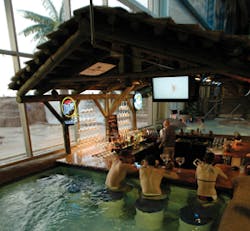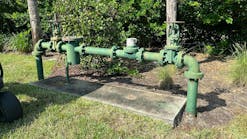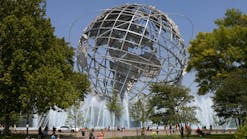Opening a water park in traditionally water-starved Las Vegas, NV, doesn’t sound like a good idea. But Wet Holdings plans to do just that.
And officials at the company, which is designing the new water park Las Vegas Wet, aren’t holding back: Their attraction, scheduled to open in 2011, will boast an indoor water park covering about 350,000 square feet, and will be the largest in North America.
There’s an obvious question here: Does this make sense in a part of the country where water is so scarce?
Steve Dooner, chief executive officer of Wet Holdings, gives an unqualified “yes” to that question. Water parks, once their pools and slides are filled for the first time, use far less water than consumers think, he says. And today’s newest parks are relying on advanced filtration and recycling systems to make sure that water is reused and that little of it is wasted.
Dooner points to some statistics from the EPA to back up his claim. The EPA says that the average US household consumes 225 gallons of water a day, equal to 82,125 gallons a year.
This means that if developers were to build five homes per acre–which would equal larger-than-standard building lots of 8,712 square feet–on the same land on which the water park will sit, construction crews would be adding 140 homes to the area. Those homes would use 11.5 million gallons of water a year. That’s 43% more than the 8 million gallons of water that Las Vegas Wet is expected to consume each year.
“I don’t think the general public understands just how careful we are to conserve and reuse water,” says Dooner. “It’s extremely important for us. For our project in Las Vegas, of course, it’s even more important. Las Vegas is still going through a multi-year drought. So, it’s extremely important to maximize the amount of water we conserve. We want to keep as much of it as possible.”
Dooner is not alone. The developers of new water parks across the country–not just in drought-stricken states–are relying on new technology and building techniques to make sure that the facilities consume as little water as possible each year.
It’s a trend that water park developers and industry analysts say will only continue.
“Conserving water is something that we are always thinking about,” says Steve Shattuck, corporate director of communications for Madison, WI-based Great Wolf Resorts Inc., which will be opening its eleventh water park in Concord, NC, in spring of 2009. “As industry leaders in the water park industry, it’s up to us to set the standard in terms of system technology.”
Misconceptions
Erik Hansen, of Hotel & Leisure Advisors, understands that when members of the public visit a water park, they see what looks like a steady rush of water flowing down twisting water slides. They see sprawling manmade rivers meandering past the snack stands, beach chairs, and inner tube rentals.
Adult guests enjoy a cocktail at the swim-up bar in the indoor/outdoor hot tub at Kalahari Resort in Sandusky, OH.
And most of all, they see giant wave pools and shimmering wading pools.
It’s little wonder that guests see all this and instinctively think that the water park they are visiting is wasting obscene amounts of water every day.
Hansen, though, knows just how much emphasis water parks actually put into conserving water. He knows how much water the parks recycle each day. And as director of development for the Cleveland, OH-based hospitality consulting firm, Hansen wrote a detailed online column about this.
His goal, he says, was to correct the misconception that water parks are water hogs.
“In my work, water parks are typically associated with resorts,” says Hanson. “There are a lot of different components in those resorts. People naturally gravitate toward the water park itself as the largest user of water in these resorts. But they really aren’t. If you dig down deeper, if you look at the water meter bills for the various components of a resort, you’ll see that the water park was actually not the heaviest user.”
Much of this is because of the way today’s water parks are designed. The slides and other rides now use higher splash aprons, Hansen says, keeping more water from leaving the rides. Other parks rely on portable flow meters that can tell maintenance staffers where leaks are occurring. The staffers can then quickly repair these leaks before too much water is wasted.
A growing number of water parks today have installed the latest in filtration and sanitation technology, meaning that they can recycle their water and pump it back through the park, Hansen says. When parks do this, they consume a relatively small amount of water following the initial “filling-up” period, he adds.
Other parks have even turned to what seem like minor techniques, such as installing slotted walkways throughout their parks that allow the water drops that fall off visitors to drip through the slots, where it is collected, sanitized, and sent back into the water park. These slotted walkways end up saving a significant amount of water when compared to the old asphalt or concrete walkways that used to be common at water parks.
“If you talk to the people who design these parks, you’ll find that the main design philosophy is to reuse as much water as possible throughout the entire design of the water park itself,” says Hansen. “You’ll notice that even the splash aprons when you get out of the pool are longer now. They slope back toward the pool. The parks are trying to recapture every drop of water for reuse. It doesn’t do any good if someone leaves and the water drips off them on the way back to the locker room. That’s just wasted water.”
Parks are taking these steps because it’s good for the environment, he says. And in parks built in arid, drought-suffering states, such steps are often necessary to win permitting approval.
The 12,000–square foot wave pool at Kalahari Resort in Sandusky features eight ocean-like wave settings.
But the parks aren’t conserving water simply because the people running them are good-hearted. Consuming less water on a yearly basis also makes good business sense, Hansen says. Water bills are a major operating expense. To cut that down provides a boost to these water parks’ bottom line.
Dooner, from Las Vegas Wet, agrees with this assessment. “The biggest cost of the water park next to labor is your water bill,” he says. “If you can consume less water, you can make a big difference in your operating budget. That’s why we are always looking at ways to keep the water in the park, to reuse our water. That’s why we are always engineering things so that as much water as possible gets back into the system.”
Dooner isn’t kidding about this. His park is one of those that will install slotted walkways to keep as much water as possible from leaving with its guests. “We use the walkways to squeegee water off our guests,” says Dooner. “Before these slotted walkways, the water would drip off and simply evaporate. That’s a waste.
“These new walkways–perforated fiberglass and resin walkways–add to the cost of construction,” he adds, “but, with the rising cost of water–which I believe will become the new oil of the next 20 years–the more we conserve, the more money we can save and put to our bottom line.”
New Technology Is Key
Higher splashguards and slotted walkways can only do so much to conserve water, though. Water parks are also turning to new technology to help them recycle and save as much water as possible.
A key element for many new parks is the Neptune-Benson Defender filter. This increasingly popular filter does not need to be backwashed; instead, it discharges spent media directly to waste. This saves more than 2.2 million gallons of water every year at a typical indoor water park attraction.
For instance, at WhiteWater World in Queensland, Australia, the Neptune-Benson Defender filtration system has saved more than 22 million liters of water every year since its installation.
The filter is now a common one at municipal swimming pools and in the water park industry, says Bob Hawken, vice president and sales manager for Neptune-Benson. Not only does the filter help park operators cut back on water consumption, it also provides other cost savings, he says.
“Whenever you have to backwash a pool filter, that water has to be replaced,” says Hawken. “It has to be chemically treated. It has to be reheated, if you’re dealing with an indoor facility. All of this adds to the cost of your operations.”
Shattuck, from Great Wolf, says that his company’s new water park in Concord–which will total 80,000 square feet of indoor space when it opens in spring of 2009–will rely on the Neptune-Benson Defender filters.
“By using the best sanitation and filtration technology that the industry has available, it makes it possible for us to recycle the vast majority of water in the water park,” says Shattuck. “The filters sanitize the water, and then filter it right back into the water park. People don’t realize this. This allows us to recycle the vast majority of the water every day. It’s cleaned and pumped right back into the pools again.”
Conservation Outside the Water Park
If you take a trip to the Wisconsin Dells, you’ll soon notice that water parks dominate the vacation spot. And most of these parks aren’t standalone entities. The majority come attached to sprawling resorts with hundreds of guest rooms.
It is actually the resort areas of the water parks that consume the most amount of water. So it’s not surprising that park operators are spending much of their time figuring out ways to reduce water consumption in these areas of their facilities.
The Kalahari resort and water park in Sandusky, OH, now uses the AquaRecycle Laundry Water Recycle System. Josef Haas, chief operating officer for the Kalahari resorts, says that he expects the system to reduce water consumption at the park by 55–58%.
This is key, because the laundry facilities at the resort get quite an amazing daily workout. On a busy weekend, the resort’s laundry cleans about 10,000 pool towels. And this doesn’t include the tools from the resort’s guest rooms.
The resort has been using the system–which cost Kalahari about a quarter of a million dollars–since May of 2008, Haas says. Depending on whether the system performs as advertised, he says, the company would install the system in its other resorts, too.
“When you are spending the kind of money that we are spending, you want to make sure that the system works,” says Haas. “If it does everything they say it will do, we will then decide whether to put it into our other water parks.”
Great Wolf also concentrates much of its water conservation efforts on areas outside its resorts’ water attractions, Shattuck says.
The Great Wolf resorts all feature a linen recycling program in every resort guest room. This means that the maid staff only changes bed linens every third day for guests that are staying more than one night. The staff does change linens whenever new guests book a room.
The resorts also run a towel reuse program in all guest bathrooms. Guests can hang up their towels instead of throwing them on the bathroom floor, to save them for another day. This small step saves a significant amount of laundry water every year, Shattuck says.
The resort uses recycling technology so that it can recycle 70% of the water it uses in its laundry facilities, Shattuck says.
“That system is second to none,” he says. “We can use that water again; we clean it and send it right back to the laundry facilities.”
In the Concord Great Wolf lodge, the faucets and showerheads in all guest bathrooms will be low-flow varieties using aeration technology. These faucets and showerheads will pump out less than two gallons of water per minute. The low-flow toilets in the guest bathrooms will use only 1.6 gallons of water for every flush.
The resort’s public men’s bathrooms will feature waterless urinals. According to Shattuck, this move alone will save 40,000 gallons a year for every urinal. “That adds up quickly,” he says.
Taking the Little Steps
In Las Vegas, the engineers who are designing Las Vegas Wet are taking into consideration the unique characteristics of their water park’s location. Not only do engineers have to worry about the blazing sun, which can cause a significant amount of water to be lost to evaporation, they also have to worry about a less-publicized culprit, the city’s high winds.
“Las Vegas is consistently windy year round,” says Dooner. “Wind will evaporate water faster than heat will. So we have designed the park to mitigate wind infiltration in the water park.”
A total of 325,000 square feet of the water park is under a massive roof. That helps to diminish evaporation caused by both the sun and the wind, Dooner says.
“Having so much of the park under the roof will certainly help mitigate the evaporation,” he says. “That will conserve between 8% and 13% of the water we would otherwise have lost to evaporation. So we are cutting that amount down.”
At the Kalahari resorts, engineers are always tinkering with ways to reduce water loss, Haas says.
For example, the park in Sandusky features an area where guests can try their hand at surfing. This leads to a significant amount of splashing, and a large amount of water that could be lost as it rushes over the surf pool’s edge.
The surf pool, though, features retaining walls and plexiglass designed to keep as much water from leaving the pool as possible.
“Once that water is over the pool’s edge, you lose it,” says Haas. “We are always looking at ways to keep the water in the pools themselves. You don’t want to just lose that water.”
Hansen hopes that, as officials at water parks do more to promote their effectiveness at conserving water, the myth that they are water-wasting beasts will fade.
“I wrote that column about how water parks actually do conserve water after, as one of my assignments, I was working up a drought management plan for a new water park,” he says. “The local jurisdiction had requested that plan as part of the requirements for the park to open. As I was doing the research, I noticed that there were a lot of misconceptions about how much water is actually used at a water park. Hopefully, these misconceptions will fade once people learn more about how the parks actually operate.”






